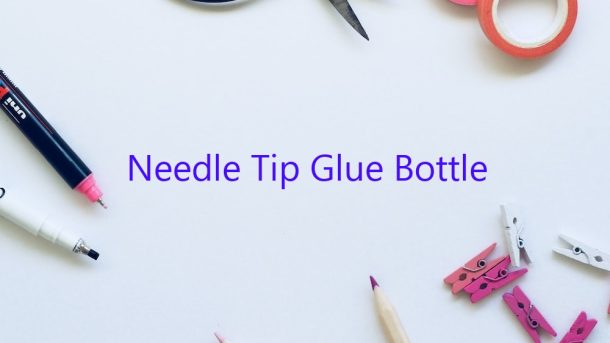A needle tip glue bottle is an essential tool for any crafter or seamstress. This bottle has a long, thin tube with a sharp point on the end, which is perfect for applying small amounts of glue to intricate details.
There are a few different types of needle tip glue bottles available on the market. Some have a metal tube with a pointed plastic tip, while others have a plastic tube with a pointed metal tip. The metal tip is more durable and less likely to break, but the plastic tip is more flexible and can be easier to use in tight spaces.
No matter which type of needle tip glue bottle you choose, it is important to make sure that the point is sharp and that the glue bottle is easy to hold. The tube should be long enough to reach the details you are trying to glue, but not so long that it is difficult to control.
Once you have a needle tip glue bottle, it is easy to start using it. Simply apply a small amount of glue to the tip of the tube, and then use the point to apply the glue to the desired location. Be careful not to apply too much glue, or it will drip down the sides of the object you are gluing.
If you are using a needle tip glue bottle for the first time, it may take a little bit of practice to get the hang of it. But once you become comfortable using it, you will find that it is the perfect tool for gluing intricate details.
Contents
How do you fill a needle nose glue bottle?
A needle nose glue bottle is a small, plastic bottle with a long, thin spout used for applying glue in a controlled manner. The spout is narrow enough to fit into the small spaces between two pieces of material that need to be glued together. Glue is dispensed from the bottle by squeezing the sides together.
To fill a needle nose glue bottle, first remove the cap. Insert the end of the bottle into the glue container and squeeze the sides together to dispense the glue. Be careful not to get any glue on the outside of the bottle, as it will make it difficult to squeeze the sides together in the future. If you do get glue on the outside of the bottle, you can clean it off with a paper towel. Replace the cap on the bottle when you’re finished.
What are needle tip bottles used for?
Do you like to craft? Do you like to make your own beauty products? If so, you may have need of a needle tip bottle. What are needle tip bottles used for? They are used to apply liquids in a very precise way. If you need to put a drop of oil in the corner of your eye, for example, a needle tip bottle is the best way to do it.
They are also great for applying small amounts of product to a specific area. If you are using a facial serum, for example, you may only need a drop or two. A needle tip bottle will help you to apply the serum exactly where you want it.
If you are looking for a way to apply your makeup with more precision, a needle tip bottle may be the answer. You can use it to apply liner or shadow in a thin line. This is a great way to create a more subtle look.
Needle tip bottles are also great for dispensing liquid soap. If you have a hand soap dispenser that uses a pump, you can use a needle tip bottle to fill it up. This is a great way to save money, since you will be using less soap.
As you can see, there are many uses for a needle tip bottle. If you are looking for a way to apply liquids with more precision, this is the tool for you.
How do you revive wood glue?
If you’re like most woodworkers, you’ve probably had the unfortunate experience of using wood glue that’s become too dry to use. But don’t despair – there is a way to revive it and get it working like new again.
The first step is to identify the type of glue you’re working with. There are two main types: aliphatic and epoxy. Aliphatic glue is the most common type, and can be revived using a simple technique involving water and heat. Epoxy glue, on the other hand, is a bit more stubborn and difficult to revive.
If you’re working with aliphatic glue, the first step is to add a small amount of water to the glue. Then, using a heat gun or a hair dryer, heat the glue until it’s liquid. Once it’s liquid, you can use it as normal.
If you’re working with epoxy glue, the process is a bit more complicated. First, you’ll need to add acetone to the glue until it’s a thick liquid. Then, heat the mixture until it’s bubbling. Once it’s bubbling, you can use it as normal.
What is the best glue to use for Quilling?
What is the best glue to use for quilling?
There are a variety of glues that can be used for quilling. Some of the most popular glues include white glue, Elmer’s glue, and Mod Podge.
White glue is a water-based adhesive that is typically used for paper crafts. It is available at most craft stores.
Elmer’s glue is a white, water-based adhesive that is also commonly used for paper crafts. It is available at most drugstores and grocery stores.
Mod Podge is a water-based sealer, adhesive, and finish. It is available at most craft stores.
Each of these glues has its own benefits and drawbacks. White glue is inexpensive and easy to find, but it is not very durable. Elmer’s glue is more durable than white glue, but it is also more expensive. Mod Podge is the most durable of the three glues, but it is also the most expensive.
Ultimately, the best glue to use for quilling depends on the individual project and the type of materials that are being used. Some projects may require a stronger adhesive than others.
How do you unclog fine tip glue pens?
Are you having trouble with your glue pen? Does the ink seem to be clogging up the tip? If so, don’t worry, you can unclog it quite easily.
All you need is a needle and some hot water. First, heat up some water on the stovetop until it’s boiling. Then, take the needle and insert it into the ink cartridge of the glue pen. Gently tap the needle on the side of the cartage to help dislodge the clog.
Once the clog is dislodged, remove the needle and let the pen cool down. Then, you can go back to using it as normal.
How do you make an applicator bottle?
Making an applicator bottle is a relatively simple process. You’ll need some basic supplies, including a plastic bottle, a sharp knife, and a hot melt glue gun.
The first step is to cut the top off the plastic bottle. Use a sharp knife to make a clean cut, and be careful not to cut yourself.
Next, use a hot melt glue gun to attach the top of the bottle to the bottom. Make sure the glue is hot and melted before you attach the two pieces together. Hold them together for a few seconds until the glue sets.
Now you have a simple applicator bottle that you can use to apply lotion, sunscreen, or any other product.
How long does wood glue last in the bottle?
When it comes to wood glue, there are a lot of variables to consider. The main question on many people’s minds is how long the glue will last in the bottle. This will depend on the brand of glue, the ingredients, and the storage conditions.
Generally speaking, wood glue will last for at least one year in an unopened bottle. Once it is opened, the lifespan will depend on how much is used and how it is stored. If the glue is exposed to high temperatures, humidity, or direct sunlight, it will start to break down and lose its adhesive properties.
It’s a good idea to keep wood glue in a cool, dry place, away from sunlight and heat. If it’s stored in this way, it should last for at least six months after the bottle is opened.




